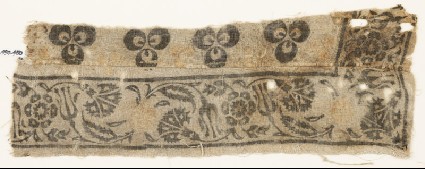Browse: 10610 objects
- Reference URL
Actions
Textile fragment with carnations, rosettes, and tulips
-
Details
- Date
-
probably 17th - 18th century (1601 - 1800)
Ottoman Period (1281 - 1924)
- Material and technique
- three pieces of fabric, possibly linen, block-printed, applied with grey, and dyed yellow; two pieces joined with a seam in flax before block-printing, and the third piece probably block-printed first, and joined with stitching in flax
- Dimensions
-
39.5 x 14 cm (length x width)
ground fabric 1, along length/width 22 / 18 threads/cm (thread count)
ground fabric 2 20 / 21 threads/cm (thread count)
ground fabric 3, along length/width 18 / 21 threads/cm (thread count)
- Material index
- Technique index
- Object type index
- No. of items
- 1
- Credit line
- Presented by Professor Percy Newberry, 1941.
- Accession no.
- EA1990.450
-
Further reading
Barnes, Ruth, Indian Block-Printed Textiles in Egypt: The Newberry Collection in the Ashmolean Museum, Oxford, 2 vols (Oxford: Clarendon Press, 1997), no. 443 on p. 130 (vol. ii), vol. ii p. 135, illus. vol. ii p. 130 fig. 443
Location
-
- currently in research collection
Objects are sometimes moved to a different location. Our object location data is usually updated on a monthly basis. Contact the Jameel Study Centre if you are planning to visit the museum to see a particular object on display, or would like to arrange an appointment to see an object in our reserve collections.
© 2013 University of Oxford - Ashmolean Museum


